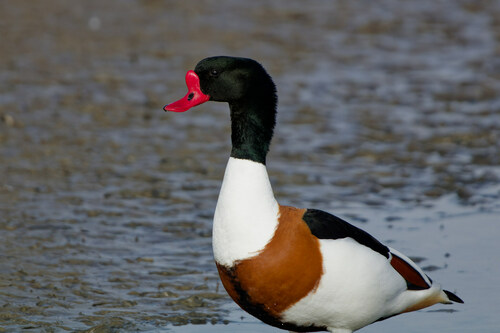
Common Shelduck
The Common Shelduck (Tadorna tadorna) is a striking waterfowl species known for its vibrant plumage and unique behavior. It bridges the gap between geese and ducks in appearance and habits, often exhibiting goose-like terrestrial grazing. Ecologically, it plays a role in coastal and estuarine ecosystems, primarily as a consumer of invertebrates and, to a lesser extent, plant material. While not holding major cultural significance in many regions, it's a recognizable and appreciated species for birdwatchers across its range.
58-67 cm
Length
110-133 cm
Wingspan
Least Concern
Conservation Status
Distribution
The Common Shelduck has a wide distribution across Europe and Asia. It breeds in temperate regions, extending from the British Isles and Scandinavia eastward through Russia and Central Asia to parts of China. Significant wintering populations are found in coastal areas of Western Europe, the Mediterranean, the Middle East, the Indian subcontinent, and Southeast Asia. It is a partially migratory species, with northern populations undertaking extensive migrations.
Lifespan
The average lifespan in the wild is around 10-15 years, but they can live longer in captivity.
Common Shelduck's Habitat
Habitat Types
Coastal areas, Estuaries, Salt marshes, Mudflats, Inland lakes (often saline or brackish)
Climate Zones
Temperate, Subtropical (wintering areas)
Adaptations
Common Shelducks are well-adapted to saline environments. They can tolerate a wide range of salinity levels and often feed in intertidal zones. They possess strong legs for walking and grazing on land, similar to geese.
Variations
While generally considered monotypic (no recognized subspecies), there can be slight regional variations in size and plumage intensity.
Appearance
Breeding Plumage
Both sexes have striking plumage year-round, but it is most vibrant during the breeding season. Males develop a prominent red knob on their bill.
Seasonal Feather Changes
The intensity of the colors can fade slightly outside of the breeding season.
Sex Based Plumage Differences
Males have a prominent red knob on their bill during breeding season, which is much reduced or absent in females. Females also tend to have slightly duller plumage overall.
Notable Features
Bold black, white, and chestnut plumage, Bright red bill (with a knob in breeding males), Pink legs and feet, White wing patches visible in flight
Diet and Feeding
Primary Foods
Small invertebrates (especially *Hydrobia* snails), Mollusks, Crustaceans, Insects, Small amounts of plant material (seeds, algae)
Foraging Behavior
Common Shelducks primarily feed by dabbling in shallow water or grazing on exposed mudflats. They often use their bills to sift through mud, searching for small invertebrates. They may also upend in deeper water.
Specializations
Their bill is slightly spatulate, aiding in sifting through mud and sediment. Their strong legs are adapted for walking and grazing.
Seasonal Diet Variations
Diet can vary depending on food availability. In some areas, they may consume more plant material during the winter months when invertebrate populations are lower.
Behavior
Social Structure
Common Shelducks are often found in pairs or small groups during the breeding season. Outside of breeding, they can form large flocks, particularly during molting and migration.
Communication
Whistling calls (males), Quacking calls (females), Visual displays (head-bobbing, wing-lifting)
Migration
Many populations are migratory, traveling significant distances between breeding and wintering grounds. Non-breeding birds often gather in large flocks at specific molting sites.
Territorial or Group Behaviors
During the breeding season, pairs are territorial, defending their nesting area from other shelducks. Outside of breeding, they are generally more social.
Conservation
Threats
Habitat loss and degradation (coastal development, pollution), Disturbance at breeding sites, Hunting (in some regions), Climate change (potential impacts on breeding and wintering habitats)
Protection Programs
Protected areas (national parks, nature reserves), International agreements (e.g., Ramsar Convention on Wetlands), Monitoring programs
Local National Laws
Protected under various national and international wildlife laws, including the EU Birds Directive.
Population Trend
Stable
Population Estimates
The global population is estimated to be between 580,000 and 710,000 individuals.
Interesting Facts
They often use abandoned rabbit burrows for nesting.
This adaptation allows them to nest in areas with limited natural cavities.
Large flocks gather at specific sites for molting.
During this time, they are flightless and vulnerable, so they seek out safe, food-rich areas.
Ducklings from different broods are raised in crèches
Ducklings from different broods often gather together in large groups, called crèches, which may be supervised by one or more adults.
Faqs about Common Shelduck
What is the difference between a male and female Common Shelduck?
Males have a prominent red knob on their bill during the breeding season, which is absent or much smaller in females. Females also have slightly duller plumage.
Where can I see Common Shelducks?
They are found in coastal areas, estuaries, and salt marshes across Europe and Asia. Look for them in shallow water or grazing on mudflats.
Are Common Shelducks endangered?
No, they are classified as Least Concern by the IUCN, meaning they are not currently considered to be at risk of extinction.
Do common shelduck migrate?
Yes, many populations of Common Shelducks are migratory, undertaking significant journeys between their breeding and wintering grounds. The extent and timing of migration can vary depending on the geographic location of the population.
Copyright @ Nature Style Limited. All Rights Reserved.
 English
English